
If you want to get the most out of your meetings and empower everyone on your team, you can’t just slap a time on everyone’s calendar and expect great results. Like every other initiative, there should be a plan for every meeting.
Meeting goals should be a big part of your overall meeting management strategy.
They keep your stakeholders focused on why you set up the meeting in the first place! Setting a measurable goal paves the way for more effective meetings, improves collaboration, and helps every team member feel like their time was well spent.
There are six types of meeting goals you can use to host more productive meetings. We’ve outlined them below and offered some actionable tips that you can implement today.
What are the main types of meetings?
Teams meet for various reasons, but when you drill down, many meetings have an overall objective in common.
Meeting types typically fall into one of six categories, each with a measurable goal attached to it. By understanding the type of meeting you’re holding, you can more easily define what type of goal you want to attach to it.
1. Planning meetings
As the old saying goes, “if you fail to plan, you plan to fail.” Planning meetings are essential for successful project management, as they help team members understand their focus and purpose. They can focus on short-term, granular, long-term, or one-time projects.
An example of meeting goals for a short-term project would be an upcoming client initiative. A long-term meeting example would be a yearly company leadership meeting. A one-time planning meeting example would be a sales team product rollout or a marketing team planning a new website.
Every attendee should gather relevant information before a planning meeting to save time and increase the meeting’s effectiveness. This proactive legwork sets the team up to create smart, attainable, and measurable goals.
Get your free planning meeting template.
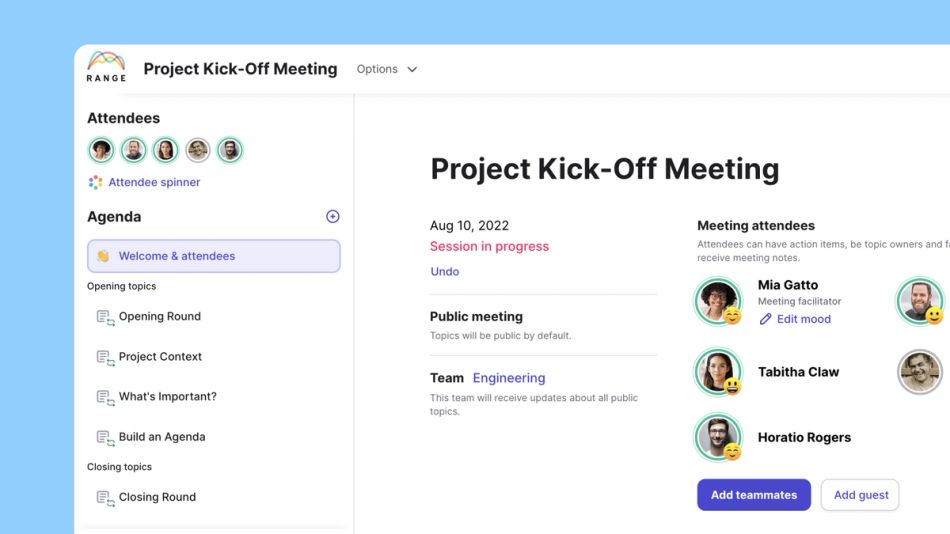
2. Problem-solving or brainstorming meetings
Meeting to create ideas and solve problems is a great way for teams to collaborate to elevate their success. However, without a goal, they can quickly become an unfocused mess with too many ideas and points of view.
Pre-set goals for these meetings, shared in the meeting agenda beforehand, allow team members to gather their thoughts before they step into the conference room (or join the Zoom meeting).
A team meeting for brainstorming and problem-solving should create the synergy that produces better ideas than individual team members would ever come up with on their own.
Get the free brainstorming meeting template.
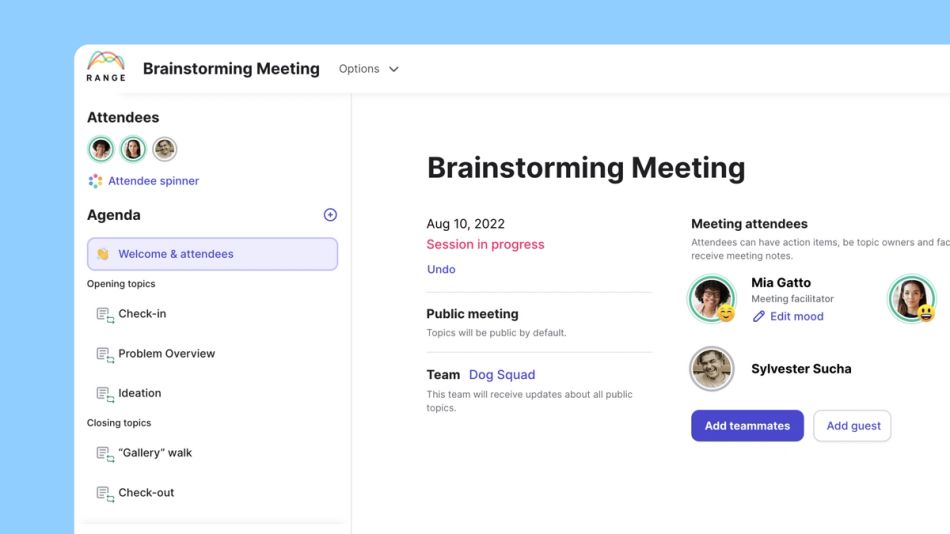
3. Decision-making and RACI framework meetings
Sales, marketing, accounting, and IT teams (and every other team on the planet) must make decisions. They may be pursuing new clients, getting rid of a low-performing vendor, adding a new project, deciding who gets promoted, investing in technology, or making a thousand other decisions related to team goals.
Every team member with a stake in the decision must be included in decision-making meetings. You can make these determinations using the RACI chart to designate who is responsible for the tasks involved.
Decision-making meetings are essential to keep an organization on track and progressing toward the company’s overarching goals.
4. Culture-building meetings
Forging a strong company culture is a recent trend for businesses. Companies reap innumerable benefits from taking the time to cultivate a positive, inclusive culture for every team member.
Meetings that strengthen team relationships, establish trust, and cultivate goodwill and empathy are vital for maintaining a positive culture.
Celebration meetings for crushing a project or achieving milestones are great examples of how managers can use meetings to build up a positive work culture.
One-on-one meetings between managers and their direct reports are another excellent culture builder that fosters trust and rapport.
Get the free one-on-one template.

5. Working session meetings
There are times when working with colleagues makes the most sense. For example, a big presentation may require the help of multiple people to produce. These are meetings that are part of the workday.
Technology facilitates these real-time work sessions, especially if the participants aren’t in the same location.
They can jump on Zoom calls, share a whiteboard, or jump into their project management software.
The goal of these meetings is usually to progress or complete a work task as a group (for tasks where this is more effective than each person working alone).
Get a free simple meeting agenda template.
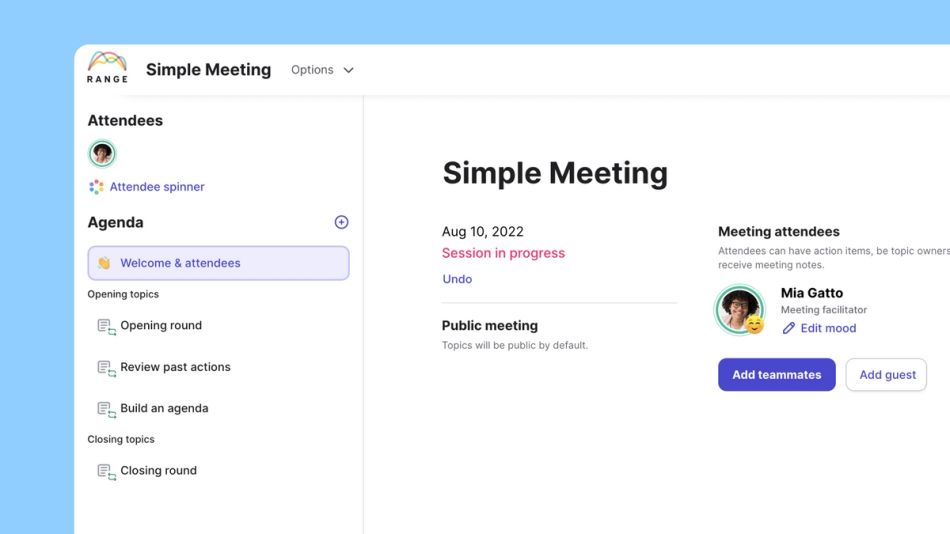
6. Feedback or retrospective meetings
Knowing how to track goals is crucial. Establishing metrics for success and reviewing them at the end of a project helps create high-performing teams that get even better as time goes on.
Meetings that dive into the results of a project or initiative and measure the good parts and the portions that could improve, are smart meetings. Identifying the strong and weak spots of the team’s performance allows managers to fine-tune it for next time.
Get the free retrospective meeting template & post-mortem meeting template.
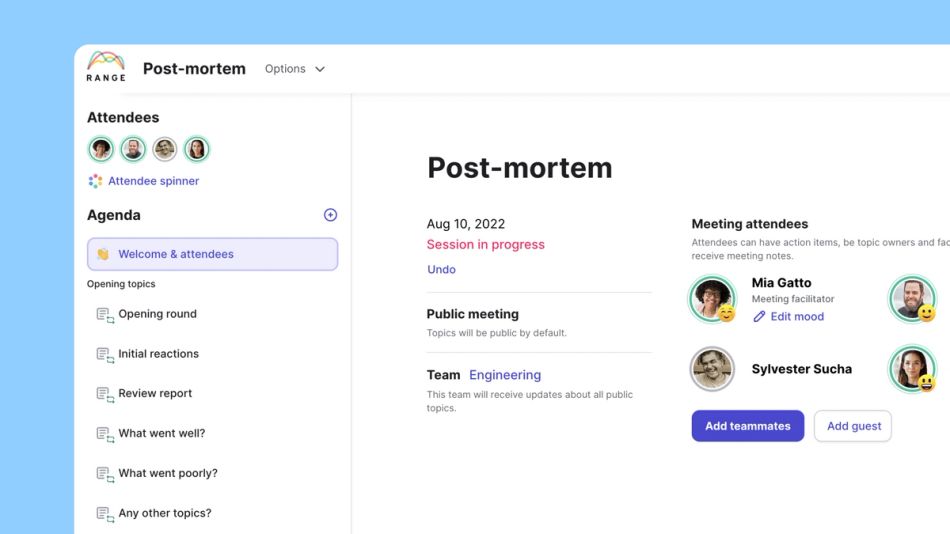
Best practices to reach your meeting objectives & goals— for every meeting type
Being aware of the different types of meetings allows leaders to set clear goals and maintain the meeting’s focus.
Managers who understand how to structure and run meetings to get the most out of them help make their teams more cohesive and efficient. Reaching successful meeting goals decreases conflicts, reduces project timelines, and increases overall productivity.
Let’s take a closer look at five best practices for setting goals for your meetings.
Start and finish meetings on time
Why should you start and end meetings on time? Starting meetings late sets a negative tone and puts the attendees on edge from the beginning. After all, nobody wants to feel like their time isn’t valued. Start meetings promptly to keep participants positive and engaged.
Similarly, team members don’t want to expect a meeting to end, only for it to run overtime. Before the meeting, carve out enough time to discuss all the agenda items and pay close attention to the time during it.
Create actionable steps when setting goals
Vague or abstract goals won’t provide the focus your team needs to make it a success. For example, instead of stating the goal as “talk about the XYZ project,” set the goal as “identify the obstacles in delivering the XYZ project on time.”
From there, you can break down the agenda into manageable talking points that keep everyone on track. You can use the SMART methodology for goal setting to assist with this best practice.
Get feedback from participating team members
Does this sound familiar?
The meeting leader drones on without soliciting others’ ideas and feedback. Every team member’s attention drifts to something else — anything else.
Every meeting needs time for two-way communication where everyone can share their opinions and ideas for reaching the meeting goal.
Be sure to encourage remote and introverted team members to share their feedback, too.
With meetings in Range, the attendee spinner Range is great for doing this. Hit spin and a person is chosen at random to share next. Everyone gets a turn to share.
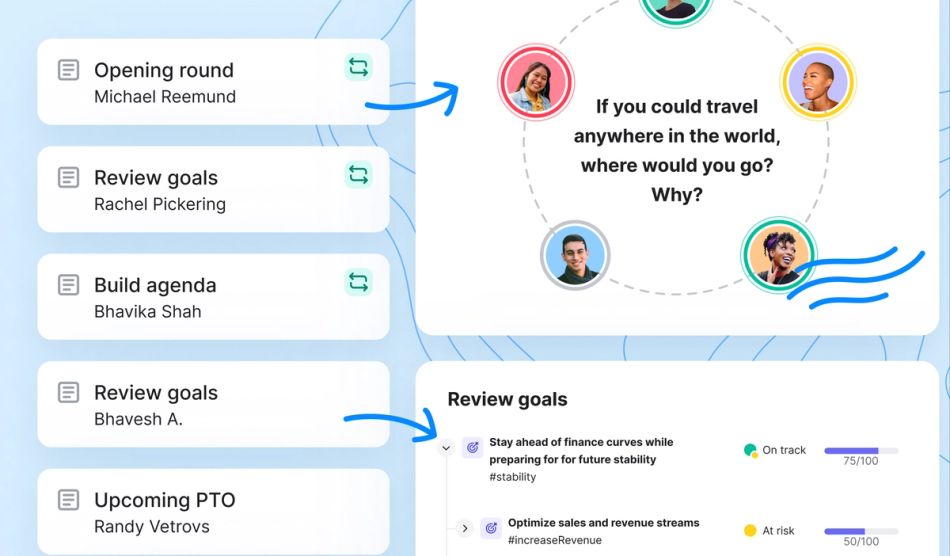
Double-check and reaffirm action items
Before the meeting starts, look over the agenda and ensure everything on it contributes to your meeting goal. Erase items that could cause the team to lose focus, and add items you may have missed when creating the list.
Schedule any follow-ups
Don’t wait until the meeting minutes are sent out to schedule another meeting time. Devote the last five minutes of the meeting to schedule the next meeting time, if needed. This allows everyone to share any conflicts in their schedule and gives everyone a timeline for when they need to complete their action items.
Have regular meetings with Range
Team meetings take up too much of our time to not accomplish anything. By understanding the types of meetings and how to set goals for each of them, leaders can facilitate effective meetings that move the needle.
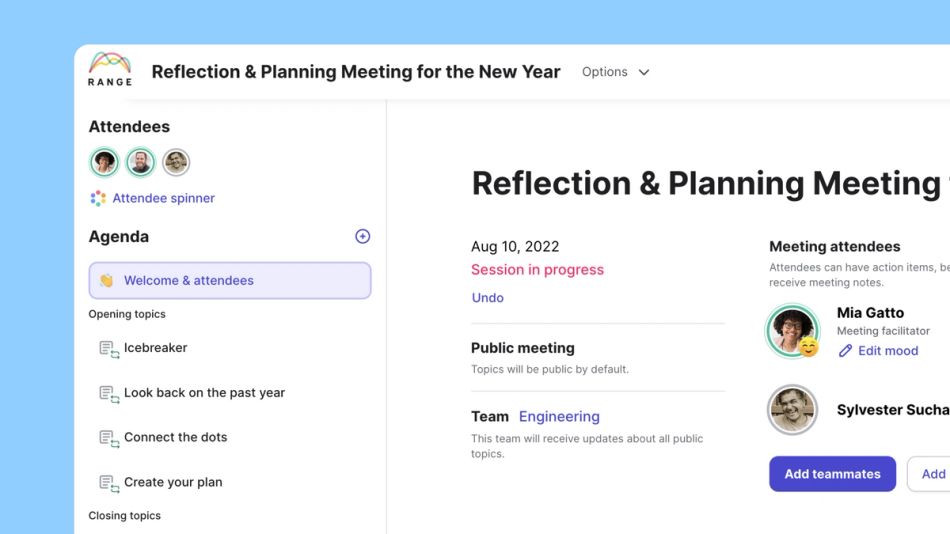
With meetings in Range, your team can:
- Easily facilitate balanced discussions that make every meeting worthwhile
- Keep everyone included and on track with much less effort.
- Build multi-player agendas, record actions, and share notes automatically
- Create a recurring agenda for all the topics your team discusses every week from metrics to project updates.
Start with a free meeting template.








